
Menu

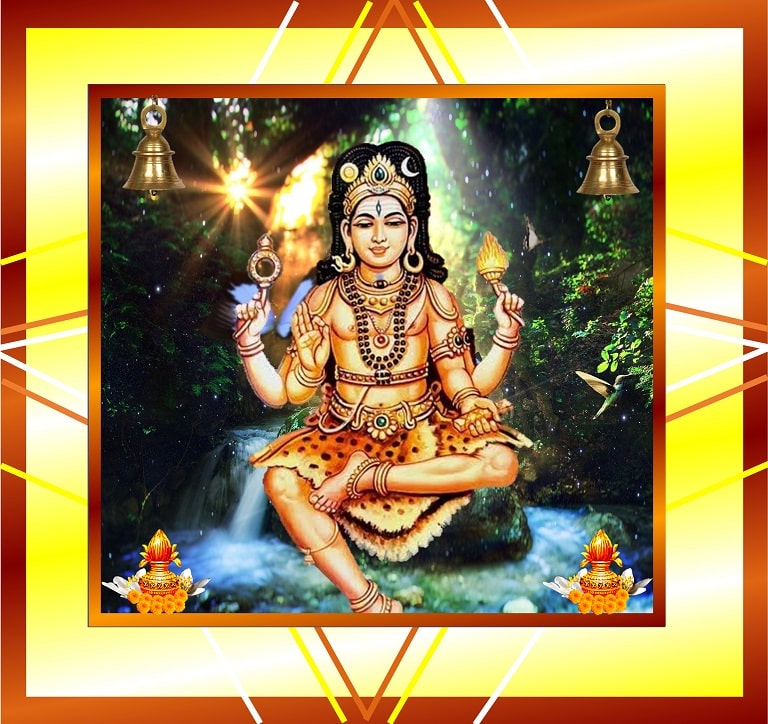
$151 USD







Lord Dakshinamurthy (தக்ஷிணாமூர்த்தி) is one of the most magnificent form among the 64 forms of Lord Shiva. In this incarnation of Lord Dakshinamurthy, Lord Shiva is said to be the most superior cosmic teacher (Adi Guru) who empowers and enlightens one with Gyan (Knowledge) that elevates the soul. This form of Lord Shiva is the personification of the ultimate Knowledge, awareness, and understanding. This incarnation of Lord Shiva depicts him as the Supreme Teacher of yoga, Knowledge, and even music. The richest treasures of Knowledge in the Shastras became accessible to the common man when Lord Shiva appeared in the form of Lord Dakshinamurthy.
Lord Shiva is worshipped as the God of wisdom. Lord Dakshinamurthy is worshiped and considered Guru (teacher) by those who don’t have a guru (teacher). If they are worth, they will be blessed with a human Self-Realised Guru. This form of Lord Shiva is of a kind teacher who grants wisdom to seekers of salvation.
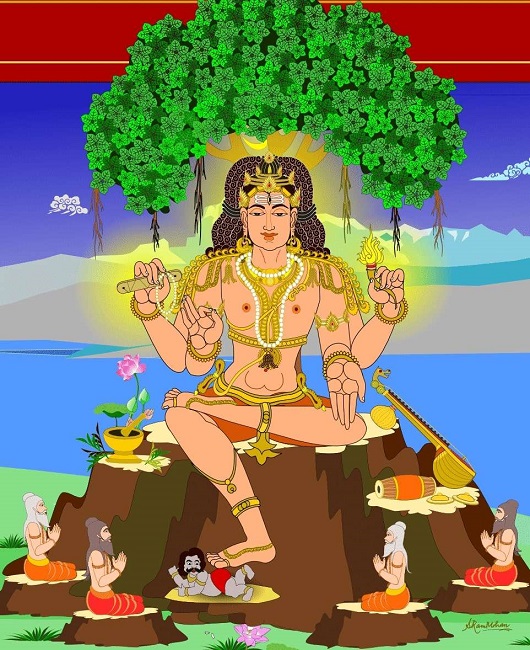
Rammohan65, CC BY-SA 3.0, via Wikimedia Commons
Dakshinamurthy means ‘one who is facing south (dakṣiṇa)’ in Sanskrit. According to another interpretation is ‘Dakshinya’ means Karuna or kindness (benevolence) in Sanskrit. This manifestation of Shiva is of a benevolent teacher who guides the seekers of salvation. Lord Dakshinamurthy is portrayed in various forms, namely: the teacher of Yoga and Tantra- Yoga Dakshinamurthy; the teacher of all arts- Veena Dakshinamurthy; and Vyakhyanamurthi– the teacher, who is the source of all scriptures and imparts all Knowledge. Lord Dakshinamurthy is described as a young teacher seated under a huge banyan tree and imparting spiritual wisdom to the aged disciples (Sages) through silence and dispelling all doubts confronting them.
In most of the Lord Shiva temples, a south-facing statue of Dakshinamurthy is installed on the Southern circumambulatory path around the Lord Shiva temple premises. Perhaps, of all Hindu Gods, Lord Dakshinamurthy is the only one sitting facing south. Lord Dakshinamurthy is one of the many forms of Lord Shiva that show his personality as a kind and humble teacher.
The traditions of India hold special respect to Guru or the teacher. Lord Dakshinamurthy, in the Hindu beliefs, is considered the ultimate Guru – the embodiment of Gyan or Knowledge and the destroyer of ignorance (as is depicted by the demon being crushed by the feet of Lord Dakshinamurthy). By keeping the foot on Apasmara, the dwarf demon, Lord Dakshinamurthy, protects humankind from two kinds of ignorance.
The Two Ignorance are:
• The illusion that one is separate from Divinity.
• The illusion that the trials of daily life are all that matter.
This manifestation of Lord Shiva is called Dakshinamurthy as he is facing south. And also, because the idol of the Deity is placed in the southern part of the temple. However, there are few other explanations too. According to Tantra Shastra, Dakshina means a woman and refers to the feminine element, which can create and manifest. When Dakshina acquires a form along with Shiva, it results in Lord Dakshinamurthy, an androgynous form of Shiva. The Tantra tradition regards and worships Lord Dakshinamurthy as Ardha-Nari.
He is called Dakshinamurthy because of his limitless compassion towards the entire creation. ‘Dakshina’ is also interpreted as grace. Lord Dakshinamurthy is considered the embodiment of grace. It is said that ‘grace’ (anugraha) is an act of limitless compassion. As Guru, he is the great ideal of spiritual wisdom adorned with grace towards all aspirants. And, only through his blessings can one attain liberation. Lord Dakshinamurthy is the Master of arts, music, and an exponent, an authority on scriptural learning; a supreme Yogi; an adept in Tantra-Vidya; and a teacher beyond compare who teaches the true Knowledge that liberates.
• Another explanation to it is; Suta –Samhita states the five faces or five aspects of Lord Shiva which are turned towards four directions and above, as the face on West: represents earth, and pervading ego; the face on North: represents water and manas; the face on South: represents fire and Buddhi (intelligence); the face on East: represents air and Maya (illusions); and above all: represents akasha (Sky) and soul.
The South face of Lord Shiva is on the right-hand side as one stands facing the Shivlinga. Hence, the South face of Lord Shiva (that which is not dreadful) is the benevolent, benign face of Lord Shiva, and it is directly related to the Knowledge that liberates and illuminates. Hence, it represents pure Knowledge; and, which is represented by Lord Dakshinamurthy. The God Dakshinamurthy, who corresponds to the south aspect of Lord Shiva, is therefore depicted as facing south.
• Another reason could be the one that is mentioned in the Padma-Samhita, which says that sanctum with main door facing East is productive of happiness; the main door facing the West increases health and nourishment; the main door facing North provides wealth and prosperity, and the sanctum door facing south leads to salvation.
As describe in Padma Samhita, Lord Dakshinamurthy teaches Knowledge that leads to salvation; thus it seems appropriate that he faces the south.
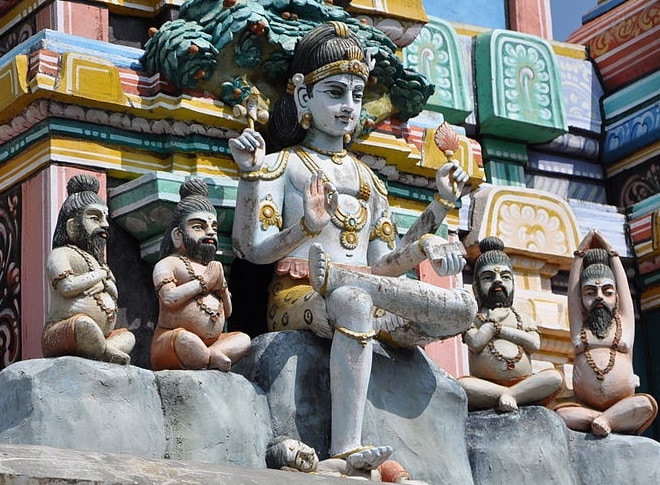
Krishna Kumar, CC BY-SA 3.0, via Wikimedia Commons
There is a legend that states that when the four Brahma-rishis Sanaka, Sanandana, Sanatana, and Sanat Kumara, who are collectively called ‘Kumaras,’ emerged from Brahma as his psychic sons (Mind born sons). The Kumaras were not interested in becoming Prajapati and helping Brahma Ji in further creating by procreating offsprings. They were constantly in search of Supreme Knowledge (Braham-Gyan). They were looking for a preceptor capable of dispelling all their doubts.
While being on the lookout for such a preceptor, they were wandering from pillar to post. They went to Mount Kailash thinking only Lord Shiva might be able to answer their doubts, but there Lord Shiva enacted as if he didn’t notice them and was sporting with Mata Parvati. Those Kumaras thought, “how can such one teach us? he is not the knower of the truth; let’s search elsewhere”, and they moved out. Mahadev knew everything that was in their minds, and it was all his sport.
Then those Kumaras again started wandering, when suddenly in one lonely place they saw a banyan tree and under that tree they found a young lad facing southward direction. He was ‘Dakshinamurthy’ sitting surrounded by sages. He was 16 years old, but the disciples surrounding him were Vashishtha, etc., senior grey-haired old sages. These four Kumaras got perplexed to see that and got gravitated to the serene-looking face of that Lord Dakshinamurthy and sat surrounding him. They put their questions to Lord Dakshinamurti. Lord Dakshinamurthy absorbed them into the supreme silence, and all their queries related to Brahman got resolved.
Another legend goes back to the marriage of Lord Shiva and Mata Sati. After marriage, Rishi Dadhichi had invited Lord Shiva and Mata Sati to his ashram. When the duo were seated there, amongst the many Rishis, Lord Shiva saw Rishi Atharva and asked him why he was uncomfortable/hesitant to speak with him.
Rishi Atharva replied that he had composed a wonderful doctrine of Knowledge and wished it get testified by a wise. And there can be no one wiser than Lord Shiva himself. So Lord Shiva blessed Rishi Atharva and started testifying his thesis. The doctrine consisted of day-to-day things, material needs, health, and medicine. Lord Shiva, after reading it, declared that the book was so necessary and was so well written that it should be titled as the fourth Veda (Earlier, there were only three Vedas: Rig, Yajur, and Sama). Though everyone praised Atharva’s Veda; the four manas putras (mind-born sons/Psychic sons) of Brahma Ji the “Kumars” (Sanak, Sanatan, Sanandan, and Sanat Kumar) did not agree to the fact that Lord Shiva, a hermit, had the authority to introduce the fourth Veda amongst the ones created by their Father.
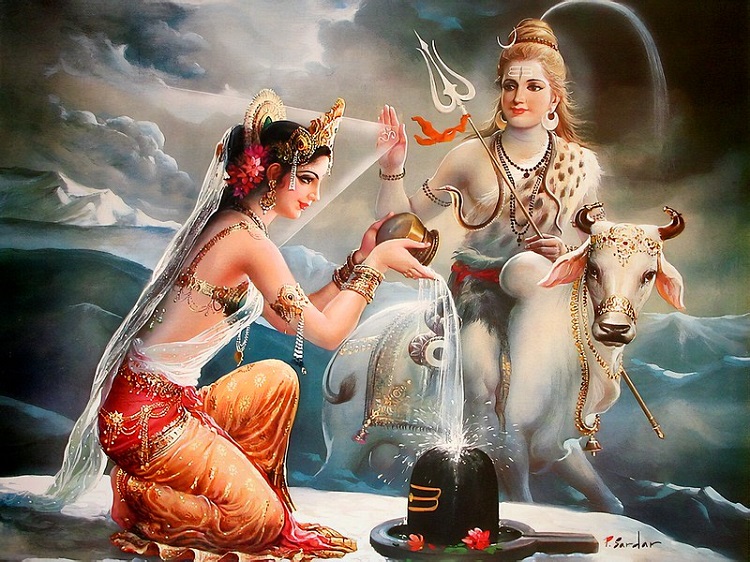
They went to Prajapati Daksha (father of Mata Sati), who asked them to have a Shastraarth (debate abiding by scriptures) with Lord Shiva. So the quad approached Dadhichi’s ashram and challenged Lord Shiva. Lord Shiva happily agreed to it. Rishi Dadhichi arranged the seating arrangement in such a way that Lord Shiva’s seat was facing North and ‘Kumars’ were facing south. It hurt the ego of the quad, who argued that due to their immense Knowledge, they should have the respect of facing North. Lord Shiva agreed to that and sat facing south.
Everyone appointed Devi Saraswati, the mother of the Vedas, as the judge to decide the result of the debate. And finally, the big debate began. While the Kumars fired numerous Vedic verses, Lord Shiva, the Maha Yogi, countered each of them, giving rational arguments backed by the initial three Vedas. As the Kumars humbled, Maa Saraswati declared Lord Shiva as the winner. However, kumaras were still confused with the fact that how could a fourth Veda exist when already three were created by Brahma Ji and how could Rishi Atharva have such immense Knowledge.
To which Lord Shiva replied that when Lord Matsya (an incarnation of Vishnu) was pinning down the demon Hayagreeva, one blow after another, to retrieve the Vedas which he had stolen from Lord Brahma; after spitting out three Vedas, Hayagreeva ran to Lord Shiva to beg for protection. Lord Shiva replied that no one in this world could save Hayagreeva from Lord Vishnu, but he blessed him that, upon his death at Lord Vishnu’s hands, he would be able to retain the Knowledge of the fourth Veda till his next Birth. Rishi Atharva is none other than Demon Hayagreeva, reborn. Lord Brahma has four heads, so definitely, there must’ve been four Vedas, but the fourth One never reached humans until now. The Kumaras praised Lord Shiva for his glory and begged his pardon for making him sit facing the southern direction. Thus, they called him as Lord Dakshinamurti (the Lord facing the South).
‘ॐ नमो भगवते दक्षिणामूर्त येमह्यं |
मेधां प्रज्ञां प्रयच्छ स्वाहा।|
Om Namo Bhagavate Dakshinamurte Yemahyam |
Medham Pragyam Prayacha Swaha||
ॐ दक्षिणामूर्तये विद्महे, ध्यानस्थाय धीमहि |
तन्नो धीश: प्रचोदयात् ||
Om Dakshinaamoortaye Vidmahe, Dhyaanasthaay Dheemahi |
Tanno Dheesh: Prachodayaat ||
Lord Dakshinamurthy is depicted facing the South. In Indian spiritual traditions, he is considered as the First Guru. The Yogis call him by the name “Adi Yogi,” and the Naths call him “Adi Nath.” The Seekers/devotees belonging to Veda, Tantra, and Agama, all trace their origin to Lord Dakshinamurthy.
Lord Dakshinamurthy is portrayed in various forms, namely: the teacher of Yoga and Tantra- Yoga Dakshinamurthy; the teacher of all arts and music- Veena Dakshinamurthy; and Vyakhyanamurthi– the teacher, who is the source of all scriptures and imparts all Knowledge. Thus, Lord Dakshinamurthy is described as a young teacher seated under a banyan tree and imparting spiritual wisdom to the aged disciples (Sages) through silence and dispelling all doubts confronting them.
Very aged Rishis are shown as students of Lord Dakshinamurthy. The old age of the Rishis/Sages represents their long journey towards attaining Moksha (salvation), and the youth of Lord Dakshinamurthy depicts immortality, despite being in a human form. Apart from Lord Dakshinamurthy manifesting as a young teacher teaching the Rishis, traditionally, it is believed that he also takes human birth from time to time to spread Knowledge. Thus, according to Hindu traditions, Lord Dakshinamurthy, in his compassion, manifests as various human Gurus and guides humankind.
The gist is that the Hindu tradition considers Lord Dakshinamurthy as being the source of all Knowledge, who teaches through the various human teachers and facilitates each individual to travel in the path towards Brahma-Gyan (Divine Knowledge/salvation). Therefore, it is said that a person requires God’s grace even to meet a genuine Guru. In Hinduism, Lord Dakshinamurthy is revered as the First Guru and the One who teaches everyone through the innumerable human Gurus.
Thursday is dedicated to the Grah Braspathi (planet Jupiter), who is referred to as Guru. For starting any educational study or venture, Thursday is considered the most auspicious day. In many temples, special prayers are offered to Dakshinamurthy on this day. Some believe that full moon night, particularly Guru Purnima is the most auspicious day to worship Lord Dakshinamurthy.
The picture of Lord Dakshinamurthy can be kept and worshipped at home. They should be placed in the South only (hang on south-facing wall). Idol can also be worshipped, but you need to perform daily Puja -rudraabhishekam. Also, do offer the garland of channa dal on every Thursday and recite Lord Dakshinamurthy shlokas. This will help to attain Knowledge.
Lord Dakshinamurthy Gayatri Mantra is a very successful medium to worship and praise Lord Shri Dakshinamurthy. Lord Shri Dakshinamurthy Ji is considered a form of Lord Shiva; worshiping him is always auspicious. Worship Lord Shri Dakshinamurthy with full reverence and devotion. Chant Lord Dakshinamurthy Gayatri Mantra with a clean and pure body and mind.
The time of morning and evening is best for the recitation of Lord Dakshinamurthy Gayatri Mantra; recitation of Lord Dakshinamurthy Gayatri Mantra in Brahma Muhurta (early morning just before sunrise) gives auspicious results. Recite Lord Dakshinamurthy Gayatri Mantra with full devotion; do not let any kind of disorder come into the mind. By reciting Lord Dakshinamurthy Gayatri Mantra, the mind remains concentrated and calm; self-confidence increases; Lord Shri Dakshinamurthy shows the right path to man so that man can achieve success.
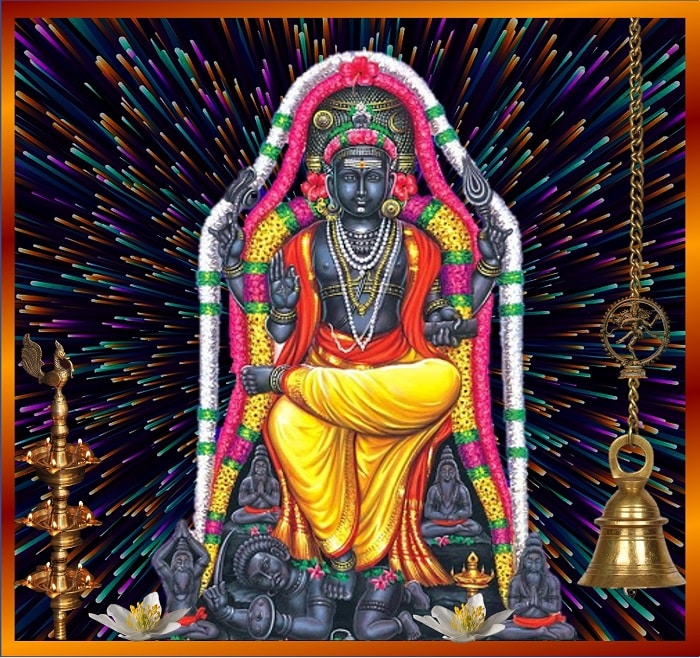
Lord Dakshinamurthy Puja with elaborate method includes rituals like:
Kalash Sthapana, Gauri Ganesh Puja, Punyavachan, Navgraha Puja, Sankalpa, Swasti Vachan, 108 chants of each planetary mantra, Invocation of major Gods, Lord Dakshinamurthy Gayatri Mantra (1100 chants), Dakshinamurthy Strotra, Dakshinamurthy Mantra Japa, Yagna, Aarti and Pushpaanjali.
Donations to Brahmins, needy people, animals, and birds play an important role for the success of the Puja.
A Stotra or Stotram is a Sanskrit word for a hymn dedicated to Deity in the form of a prayer, a description, or a conversation. Adi Shankara wrote the Lord Dakshinamurthy Stotram. It is believed that one who chants it with devotion is freed of bondages and realizes the truth. It comprises of ten stanzas that give a concise and vivid description of the philosophical importance of this manifestation of Lord Shiva.
• Lord Dakshinamurthy Puja is beneficial to excel in studies and education.
• Lord Dakshinamurthy’s mantra chanting and Yagna are also beneficial for wisdom, Knowledge & intellect.
• One should conduct Lord Dakshinamurthy Puja for the blessings of Lord Shiva and spiritual enlightenment.
• Lord Dakshinamurthy Puja is also beneficial for self-knowledge & for self-empowerment.
• Lord Dakshinamurthy Puja is extremely good for clearing competitive examinations.
• When the student is weak and is in doubt to clear the exam, this Lord Dakshinamurthy Puja bestows confidence and power to the student, and he/she passes the examination.
• Lord Dakshinamurthy Puja is very beneficial for panic and psychic attacks.
• Lord Dakshinamurthy Puja removes the nervousness and blackout condition of the student and bestows enormous Knowledge and confidence.
• Lord Dakshinamurthy Puja is highly effective for students who are determined to pursue higher education and a doctorate in foreign countries.
The depictions of Lord Dakshinamurthy as icons or paintings vary according to the beliefs of the people. Each of these forms of icons conveys different meanings. Every Shiva temple has Lord Dakshinamurthy facing the south direction even though the depiction of the Lord himself might be different.
Lord Dakshinamurthy is usually shown in a seated position under a banyan tree, facing the South. He is depicted seated with his right leg stretching downwards. This leg is resting upon a dwarfish demon (Apasmara) that lies on the ground. This demon represents ignorance, lack of Knowledge, and illumination. His left leg is folded at the knee, and the foot is resting on the right leg’s knee or thigh. The place where Lord Dakshinamurthy sits is covered with deer or tiger skin, as is usually shown in the case of Lord Shiva. His face is adorned with a calm smile and yet carrying the powerful glow of Knowledge. Many sages are also shown sometimes, sitting near the Lord, longing for his guidance and teachings. There are a few instances where the Lord is shown in the standing position, holding his veena -the musical instrument that He efficiently plays.
The Lord Dakshinamurthy wears Rudraksha bead malas (garland) along with flowers, embellishments, and garlands that decorate his sandalwood paste-covered chest. His hands are in the Gyan Mudra and have an expression of meditative serenity on his face as the Sages look towards him for the light of Knowledge.
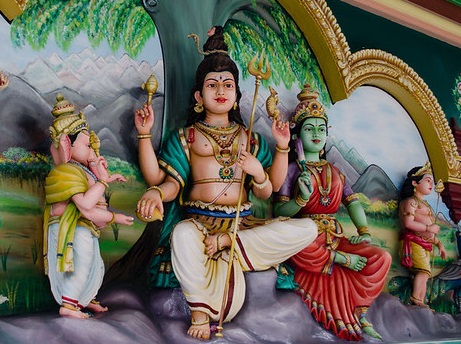
The Gyan Mudra is interpreted in this way: The thumb symbolizes God, and the index finger symbolizes the human. The other three fingers represent the three impurities of humans – arrogance, illusion, and bad deeds of the past births. When a person frees himself from these impurities, the person reaches God. Another belief is that the three fingers symbolize the three stages of life: Jagruti -Fully awake through senses and mind, Swapna -Sleep state – When the mind is awake and Sushupti -True-self – When the senses and mind meet the soul – Atma.
This hand is also shown in the Abhaya Mudra, a posture of blessing. In Abhaya Mudra, the hand is shown lifted above thigh with palm facing outwards and fingers pointing towards his students. In his form as Jnana Dakshinamurti, Lord Shiva is also shown with four arms. Sometimes even the wild animals are shown to surround Lord Shiva. In his upper arms, he holds a Rudraksha Mala or snake or both in one hand and a flame in the other hand, while in his lower right hand is shown in Gyan Mudra, his lower left hand holds the scriptures. The right hand is in the Jnana Mudra/Gyan Mudra (or Jana Mudra), a symbol of Knowledge and wisdom with the index finger of his right hand bent and touching the tip of his thumb. The other three fingers are stretched apart. The fire symbolizes illumination, removing the darkness of ignorance.
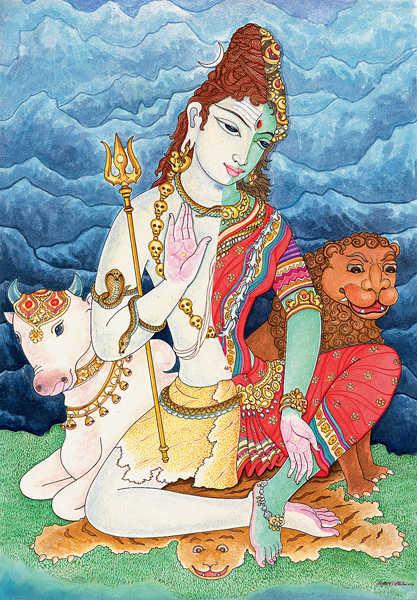
Lord Dakshinamurthy is also depicted in the Ardha-Nari form of Lord Shiva. “Dakshina” means a woman; and refers to the feminine aspect, which can create, and manifest. Therefore, when Dakshina joins with Shiva and acquires a form, it results in Dakshinamurthy, an androgynous (partly male and partly female in appearance) Lord Shiva’s form.
Lord Dakshinamurthy’s Ardha-Nari depictions can be seen in some temples; for instance, in the Shivanandeswarar temple in Thirupanthurai (Tanjore) and temple in the Thirupulivanam, near Chennai. Lord Dakshinamurthy is depicted as a powerful form with ever-flowing bliss and supreme happiness while being in the yogic state of meditation. Variations of this manifestation include Veenadhara Dakshinamurthy (holding a Veena), Rishabharooda Dakshinamurthy (mounted on a Rishabha – the bull), and the teacher of Yoga and Tantra- Yoga Dakshinamurthy.
Yoga Dakshinamurthy is an aspect of Shiva as a guru (teacher) of Yoga and Tantra. In his aspect as Yoga Dakshinamurthy, Lord Shiva is depicted generally in these two styles:
He is shown sitting in padmasana posture and engrossed in meditation. He is shown as having four arms. However, his four arms are depicted in different ways. He holds his trident (Trishul) and a human skull bowl in the upper right hand and upper left hand, respectively; His lower right hand is shown in Gyan mudra while the lower left hand is shown in Abhaya Mudra.
In another depiction, he is shown seated under a banyan tree with one leg on the ground while the other leg rests on his thigh. He is shown as having four arms. He carries a Rudraksha mala in his upper right hand; carries fire in his upper left hand; the lower right hand is depicted in dyana mudra, and the lower left hand is shown in Abhaya Mudra. Below his seat, two deers are shown squatting, and a cobra wound around his right arm looks towards him.
The traditions of India hold special respect to Guru or the teacher. Lord Dakshinamurthy, in the Hindu beliefs’, is considered the ultimate Guru – the embodiment of Gyan or Knowledge and the destroyer of ignorance (as is depicted by the demon being crushed by the feet of Lord Dakshinamurthy). Lord Dakshinamurthy is the One who is south-faced. He is considered as the source of all types of Knowledge. Lord Dakshinamurthy is the depiction of Lord Shiva, which illustrates him as the supreme cosmic teacher (Adi Guru) who enlightens us with Gyan (Knowledge) that elevates and enriches the soul. He, as the ultimate Guru, truly illuminates the world with cosmic Knowledge.
This form represents Lord Shiva as a teacher of yoga, music, and wisdom. Lord Dakshinamurthy is worshipped as the God of wisdom, complete and rewarding meditation. The treasure of Knowledge in the Shastras becomes accessible to common human beings when he appears as Lord Dakshinamurthy. Lord Dakshinamurthy guides the courses of Srishti-creation), sthiti (preservation), samhara (amalgamation), tirobhava (suppress on), and anugraha (revealing true Knowledge).
Lord Dakshinamurthy teaches a divine speech that is inaudible to worldly ears and resides in the recesses of silence. Lord Dakshinamurthy never speaks but imparts Knowledge through his gaze. Lord Dakshinamurthy’s face conveys lots of emotions-patience, serenity, and happiness. Lord Dakshinamurthy explains the true meaning of Brahman Gyan (Supreme/Divine Knowledge. He is depicted with old Rishis and sages as disciples. He imparts the ultimate awareness, understanding, and comprehension.
Lord Dakshinamurthy is the Guru of Dev guru- Brihaspati. As per Shiva Purana, Brihaspati Ji did hard penance to please Lord Shiva – Lord Dakshinamurthy who then not only conferred upon him the title of Devguru but also gave him immense spiritual powers. Lord’s kindness is boundless, and he is eager to bless his devotees. Therefore, devotees often worship him to appease Brihaspati Ji, the most auspicious planet in Vedic astrology.
Not many temples are dedicated to Lord Dakshinamurthy, but He remains an important form of Lord Shiva. Invoking him is like paying obeisance to Knowledge, wisdom, and perceiving the path of true enlightenment.
The saying-“मातृ देवो भव, पितृ देवो भव, आचार्य देवो भव” “matru Devo bhava, pitru Devo bhava, acharya Devo bhava” means mother, father, and the teacher are equal to God ( Ishwara/Brahman) is a well-known and deeply ingrained wisdom in Hindu tradition. The term Guru is often translated as a “teacher,” but the English word does not completely convey the meaning of Guru. In modern vocational teaching, teachers use teaching as a means of livelihood. Acharya/ Guru is one who teaches subjects, along with their practical application and the deeper symbolic meaning. That is, Guru is one who guides the pupil on the path to liberation.
Thus, in the Hindu traditions, Guru is one who imparts spiritual wisdom and facilitates a person to attain Braham-Gyan (Supreme Knowledge). Hence, they become free from ignorance, which causes the bondage of birth and death. This specific role of the Guru is manifest in the very name itself. The letter ‘gu’ relates to darkness; the letter ‘ru’ means the one who eliminates darkness, ‘Guru’ is called so because of his capability to eliminate darkness ( ignorance). Thus, Guru plays a very important role in Hindu tradition, irrespective of whether he imparts less or more preliminary or advanced teachings.
There are three notions of Guru: one as a human teacher, who is external to an individual, secondly as the inner Self/Atman, who shines as Buddhi (intelligence), and thirdly as God himself bestowing his grace. These three notions are deeply rooted in the Hindu tradition. These three notions regarding a Guru are best illustrated by Lord Dakshinamurthy, who is all in one- Guru, God, and Self/Atman.
• Mahakaleshwar Jyotirlinga is the only one of the twelve Jyotirlingas which is south facing, Dakshina Mukhi as such also called Dakshinamurthy. As a site of learning, it holds special significance among the Lord Shiva’s devotees.
• Lord Dakshinamurthy temple at Sukapuram in Malappuram district, Kerala, is estimated to be 1500 years old.
• The Deity is worshipped in three forms in a day at the famous Lord Shiva temple of Vaikom town in the Kottayam district of Kerala. Lord Dakshinamurthyin the morning, Lord Kirathamurthy in the afternoon, and as Lord Umamaheshwara in the evening.
• Ettumanoor Mahadevar Temple in Kerala, here Lord Dakshinamurthy is in the form of a Shivlingam.
• Nearly 500-year-old Lord Dakshinamurthy Temple at Pattamangalam village, in Sivagangai District, Tamil Nadu.
• Lord Dakshinmurthy is depicted in the Ardhanari form at Sivanandeswarar temple in Thirupanthurai, Tanjore, Tamil Nadu.
• Thirupulivanam temple also enshrines Lord Dakshinamurthy in the form of Ardhanariswara. This temple is 5 km from Uthiramerur, near Chennai.
• At Chibavananda Ashram in Theni, western Tamil Nadu is Pragya Lord Dakshinamurthy temple.
• Nearly 1000 years old Lord Dakshinamurthy temple is Situated at Poonthottam village in Thiruvarur, Tamil Nadu. On the day of Mahakumba Mela held 1000 years ago, the Deity’s idol was installed here.
• The swayambhoo temple (self-evolved) of Lord Dakshinamurthy at Vellave near Taliparambu (Kannur District, Kerala).
• Panaickal Dakshinamurthy temple at Kadakkarappally in Alappuzha District, Kerala.
• The most famous temple dedicated to Lord Shiva in Tamil Nadu is Lord Dakshinamurthy Temple, located in Mayiladuthurai. Lord Shiva is worshiped as a form of Dakshinamurthy. The idol in this temple has four hands, which is situated under a banyan tree. The idol god has a flame in his hand and a snake in the other hand. He always has his hands in Gyan Mudra, which is a symbol of wisdom and Knowledge. This entire temple is dedicated only to Lord Dakshineswar.
• In March 2007, a big temple of Lord Dakshinamurthy (the first in Maharashtra) was built in the Shrutisagar Ashram, about 30 km from Pune.






